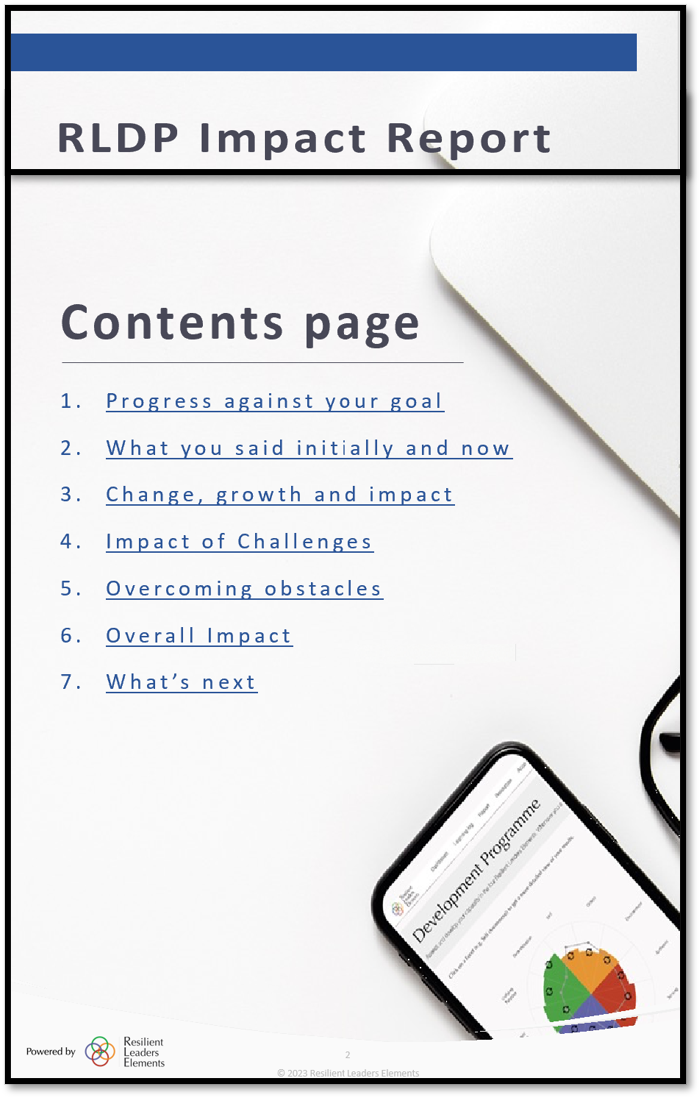This page will methodically illustrate how the RLDP meets the requirements for effective professional development - in accordance with Sims et al. (2021).
Mechanism 1: Managing cognitive load
The RLDP seeks to manage cognitive load by providing a clear, logical process. This is supplemented by strategically placed signposts to direct you through the programme and around the platform. Free access to an additional complimentary resource (below) provides text and visual cues to accompany a thorough worked example of every stage of the programme. A series of succinct video extracts illuminate each step as a practising teacher and Resilient Leaders Elements’ co-founder methodically unpack the programme’s functionality.
Professional learning is geared around the notion of
leadership strengths. These are helpfully categorised and progressively
revealed by peeling back layers. The first divides leadership dimensions into ‘What
I do’ and ‘Who I am’. These are further separated into four elements. Each
element contains three facets, each of which hosts a range of associate
statements attributed to the experience of leaders operating in a variety of
fields. The overlay of aggregated/anonymised feedback responses increases the
sophistication (and intrigue).
Mechanism 2: Revisiting prior learning
Your strengths – presented in both profile and narrative
form, can be revisited at any point in the programme. The Strength Engine is
specifically designed for you to draw on prior learning by selecting
those attributes that are deemed to be most useful in addressing an imminent
pressing need or situation.
Mechanism 3: Setting and agreeing on goals
Meaningful *goal* creation is at the core of the RLDP. A
helpful guide supports this crucial aspect of the programme.
Mechanism 4: Presenting information from a credible source
The origin and personnel behind the RLDP are highly credible. Derived from
experiential leadership qualities required when pressure turns to stress,
several officers in the SAS contributed to the early formation and trialling of
the RLDP. Leaders from other arenas including clinical psychologists and
education evolved the tool as it became holistic in its application. I (Dr Sean
Warren) have been involved from the start. Its originators, Rachel McGill and
Dr Jeremy Mead are both highly accomplished in their respective fields. Twenty
years on, a multi-faceted intuitive digital programme can be facilitated by a
virtual coach (and analysed with colleagues/external RL Consultant).
Mechanism 5: Providing affirmation and reinforcement after progress
A thorough analysis review has validated the effectiveness
of the tool showing detailed evidence of personal and professional growth. Data
shows on average participants register a 20% growth between their first and
second assessments on intensive programmes so
providing affirmation of strengths associated with leaders. There is
an enormous range but reassessment is typically 3 months. Longer-term
programmes yield 40% growth.
Mechanism 6: Instructing teachers on how to perform a technique
Here the RLPD emphasizes Professional Learning (as opposed to pupil learning). For
example, how might CPD leaders be instructed on how to utilise their
leadership strengths to ensure staff are inspired? How might the leader create
and maintain momentum for an initiative or programme? Dr Mead’s data analysis
revealed a comprehensive set of correlations between statements to provide us
with an essential menu to increase the likelihood of having a positive impact.
Mechanism 7: Arranging practical social support
The Programme need not be used in isolation. Teams and
participating cohorts can provide social support for each other in
accordance with needs inherent within collective data.
Mechanism 8: Modelling the technique
The strategic pairing of personnel can provide opportunities for modelling specific strengths within the programme
Mechanism 9: Providing feedback
The second of three engines within the RLDP is the Feedback
Engine. This enables invited colleagues to contribute their experience of the
CPD leader and her/his work. Responses are aggregated and anonymised to
encourage honesty. The programme automatically places feedback onto
both the element/facet and statement levels.
The data provides further stimulus for reflection/dialogue
by categorising the feedback into four themes including ‘Hidden Strengths’ and
‘Blind Spots’.
Mechanism 10: Rehearsing the technique
The feedback can also be selected to become part of the
leader’s Challenge Engine so they have a sustained opportunity
to rehearse leadership strengths in need of development. The RLPD’s
associate Learning Log enables the leader to monitor insights that emerge
from this activity.
Mechanism 11: Providing prompts and cues
The programme automatically provides prompts for the leader to work on
aspects of their profile calculated to be most in need of development. Each
challenge contains 10 progressive cues to build a comprehensive focus on a specific underdeveloped (or less utilised) leadership strength. Progression is indicated by the change in status of a series of stars to signify a challenge has been
completed.
Mechanism 12: Prompting action planning
The challenges provide opportunities for reflection and action. The Strength Engine
specifically utilises the most pertinent strengths to create an action
plan for a current/forthcoming situation that requires attention.
Mechanism 13: Encouraging self-monitoring
The learning log ensures the leader monitors their progress in
methodically building less developed leadership strengths identified by data in
the profile/feedback from colleagues. Your developmental journey can be
downloaded to contribute to your reflective journal.
Mechanism 14: Prompting context specific repetition
The combination of the leader’s profile, their narrative
detailing context and the feedback from colleagues ensures the leader has ample
direction and motivation to practice their leadership strengths as they
continue to carry out their strategic role as CPD leader. Data analysis reveals
that between the first and second self-assessments leaders tend to grow into
the strengths their colleagues initially recognised. It is here that the 20%
average growth is influenced by context-specific aspects connected to
your role rather than an abstract metric measure.

And all key data and insights are collated into a comprehensive impact report to stimulate and inform ongoing learning.
Key Documents
Can you provide a succinct video showing the mechanisms?
Yes, in case you missed the missed the opportunity at the top of this page, click on the link to view a video clip.
Is there a document to lead me through this research?
Yes, click on the link to review a user friendly guide.
Is there an in-depth review that provides a rationale for the mechanisms?
There is, click on the link to review the detail.





